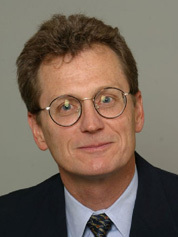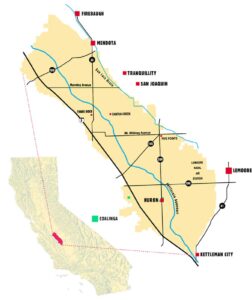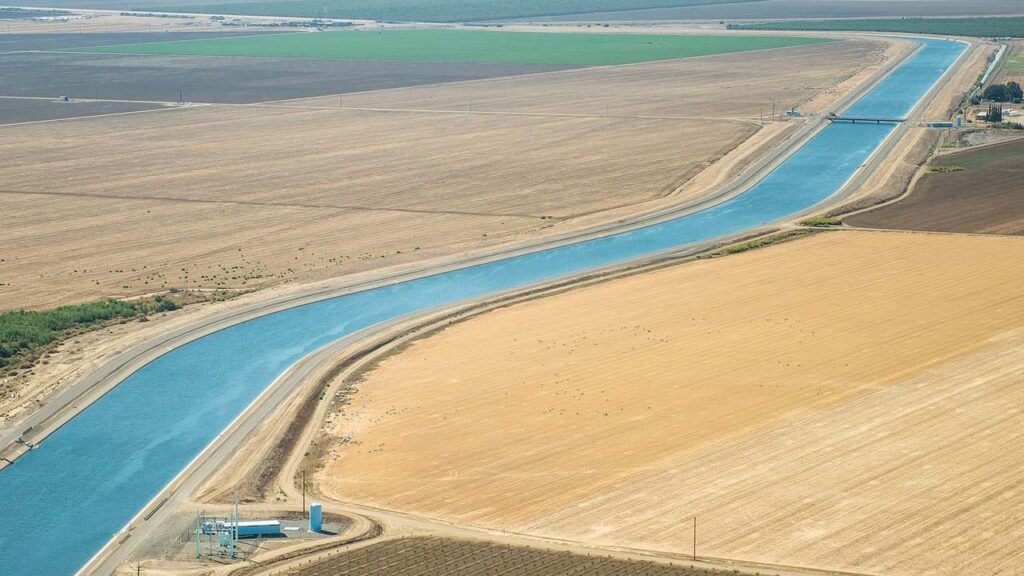The makeup of the Westlands Water District board will change this election – shifting power to a coalition of growers with a list of new actions, at the top of which appears to be ousting longtime General Manager Tom Birmingham.
“There needs to be a change of leadership, that’s a foundational issue,” said Sarah Woolf, a member of a Westlands farming family, who helped organize the coalition. Woolf also served on the Westlands Board, resigning in 2018 after issuing a letter that publicly called the district out as mired in outdated methods that left it “fighting over the scraps.”
In the years since, Woolf has worked with Jon Reiter, with McConnell Farms, to gather like-minded Westlands growers who want to find ways to enhance water resources regionally rather than leaving farmers completely at the mercy of supplies from the Sacramento-San Joaquin Delta.
Going in to the current election, Reiter and Woolf said, the board already had two so-called “change” directors on the board, Kevin Assemi with Maricopa Orchards and William Bourdeau with Harris Ranch. Though Bourdeau said he is not in any camp, calling himself strictly independent.
This year, there are four director seats up for election. Only one incumbent is running.
After hearing from frustrated growers for several years, Reiter and Woolf encouraged a slate of “change candidates” to run for all four seats.

Even if the one incumbent in the at-large race wins, that will still give the change coalition a minimum of three new directors, giving it a majority of five on the nine-member board.
That could mean the end of General Manager Birmingham’s long reign over Westlands.
Controversial leader
Birmingham served as the district’s general counsel for several years before also taking on the job as general manager in 2000. In 2016, the board split up the jobs again, hiring a separate general counsel to “promote more transparency and good government practices,” according to then Board President Don Peracchi.
Birmingham’s heavy focus on lobbying and litigation, as well as his notoriously imperious style, generated controversy within the district.
That came to a public boil in Dec. 2021 when Birmingham succeeded in having his contract extended another three years one full year before it expired. Several growers at that contentious meeting asked for a delay until after this election. But the extension passed 8-1, with Bourdeau the lone “no” vote.
Birmingham declined to comment for this story saying he didn’t want to appear to be attempting to influence votes.
Though Woolf and Reiter said the change coalition’s post-election task list contains more than just replacing Birmingham, incumbent director Ryan Ferguson, with Ferguson Farming, who is up for election, said he thinks Birmingham is the group’s main focus.
“They aren’t putting forth any new ideas,” he said. “They’re not presenting a plan of what this change will be.”
A mailer for the change candidate slate, however, lists several issues:
- Urgently develop groundwater recharge
- Create clear pumping regulations
- Develop a strategic plan that incentivizes farming alternatives including land retirement, conversion to solar or other uses
- Improve relations with other water districts, disadvantaged communities, environmental and drinking water advocacy groups.
“My No. 1 issue is recharge projects,” said change candidate Ross Franson, with Woolf Farming. “We won’t survive unless we’re able to soak up as much water as possible in wet years to get us through the dry ones.”
The district’s focus on politics, litigation and fighting against the regulatory landscape has neglected possible regional solutions, he said.
Franson was the only change candidate who agreed to be interviewed. The other three change candidates on the slate are Jeremey Hughes, Ernie Costamagna and Justin Diener.
Pugnacious reputation
Westlands is well known for its many lawsuits, pushing for reforms on delta operations, advocating to raise Shasta Dam and to build the Sites Reservoir near Sacramento.
The district gained even greater notoriety in 2019 when its former lobbyist David Bernhardt was named Secretary of the Interior under the Trump administration. Interior oversees the Bureau of Reclamation, which delivers water to Westlands through the Central Valley Project.
Despite concerns that Westlands benefited from the relationship, an Inspector General’s report released last spring found no evidence that Bernhardt violated lobbying laws with regard to Westlands during his time as Secretary.
But the perception of backroom dealing may have cost Westlands the ability to convert its biennial federal water contract to a permanent contract.
Environmental groups sued to block Westlands’ contract conversion, calling it a “sweetheart deal” under Bernhardt’s administration even though contract conversions are part of a 2016 law signed by former President Obama and are allowed for all CVP contractors. The conversions don’t increase water supplies or rights to water for any contractors, including Westlands.
Westlands’ conversion was successfully blocked in 2021 and remains in limbo.
That kind of reaction to Westlands is partly the district’s own fault for its often pugnacious stance on water issues and partly undeserved, candidate Franson said. High on his to-do list, if elected, is to create more transparency within the district and reach out to the public to dispel fears of Westlands as a power-mad water grabber.
“Some of (legal fights) may be unavoidable, but I think the money would be better spent elsewhere,” Franson said.
The charge for more recharge
Incumbent Ferguson absolutely agreed with the change coalition about one thing, the need for more groundwater recharge. But he insisted the district has been working on the issue already.

Most of Westlands overlies a formation known as Corcoran clay, a nearly impermeable layer of earth found at various depths. Percolating water in typical recharge fashion doesn’t get it past the clay and into the deep aquifer, where most of Westlands growers have to pump, explained Kitti Campbell, director of the Westside Groundwater Sustainability Agency (GSA), which covers Westlands Water District.
To get water into the deep aquifer, she said, it has to be injected. District staff worked over the last several years to get permits allowing water injection wells at more than 400 sites in Westlands and will have nine district-owned injection wells completed by the end of 2023. Those wells will be focused on subsidence-prone areas where land is sinking from overpumping. Twenty other injection wells have been completed by private landowners in the district, she said.
Westside GSA has received $14 million in grant funding for recharge, she said. It has also revised policies to encourage private recharge and bought property to do some traditional recharge, according to Campbell.
“We are, obviously, active on recharge,” Ferguson said.
Too little, too late?
Reiter and Woolf applauded the district’s recharge efforts, but noted the Sustainable Groundwater Management Act, which requires subbasins to bring aquifers into balance by 2040, was passed eight years ago and recharge efforts at Westlands have languished behind other districts.
Reiter noted that in 2017, a record water year for California, Westlands lost out on massive amounts of flood water because it had no place to store it.
The consequences of that failure are stark when looking at other districts, Reiter said.
Westlands’ growers got a 0% water allocation from the Bureau of Reclamation this year, as well as last year. With supplemental water on the open market scarce, Westlands growers barely got a “drop in the bucket,” Reiter said.
Meanwhile, in the Wheeler Ridge-Maricopa Water Storage District in Kern County where Reiter is a board member, growers got 37% of their normal amount, even with only a 5% allocation from the State Water Project. That’s because the district has spent years developing and banking water in wet years.
“That’s not right,” Reiter said of Westlands’ lack of banked supply. “It hasn’t been right over the last 25 years but it’s certainly not right in today’s world of SGMA.”
Avoiding the bad news
Along with banking water in wet years, districts also have to set clear pumping limits, something Westlands has flip-flopped on leaving growers confused, Reiter and Woolf said.
Pumping allocations have been changed at the last minute and growers still don’t know if transitional allocations can be carried over from one year to the next, they said.
“It’s almost as if the district doesn’t want to tell growers the bad news,” Reiter said.
As for the physical difficulties of banking water in Westlands, Reiter, Woolf and Assemi said that’s exactly why Westlands should be working with other districts, disadvantaged communities and environmental groups.
Instead, Woolf said, Westlands has actively tried to thwart innovative banking projects. For example, the Woolf and Assemi groups joined with the City of Huron to get a water permit on the usually dry Arroyo Pasajero Creek in order to bank its occasional floods. The project would bolster groundwater supplies for farming and provide 500 acre feet for Huron’s 6,200 residents.
Westlands opposed the water right permit, Woolf said. The permit was approved and Westlands appealed the approval. The permit was approved again and the project proceeding without the districts. Woolf said she’s hopeful new leadership will collaborate with landowners on these types of projects.
Reiter added that California Sustainable Conservation, a public interest group, developed a tool to help water managers and growers pinpoint the best groundwater storage areas (which SJV Water wrote about in 2020).
“You’d think Westlands would want to collaborate with a group that wants to help farmers,” Reiter said. “But, nothing. They can’t even get a meeting.
“That’s the kind of thing that needs to change.”
Share this:
- Click to share on Facebook (Opens in new window)
- Click to share on Twitter (Opens in new window)
- Click to share on LinkedIn (Opens in new window)
- Click to share on Reddit (Opens in new window)
- Click to share on Tumblr (Opens in new window)
- Click to share on Pinterest (Opens in new window)
- Click to share on Pocket (Opens in new window)
- Click to share on Telegram (Opens in new window)
- Click to share on WhatsApp (Opens in new window)
- Click to print (Opens in new window)








You must be logged in to post a comment.